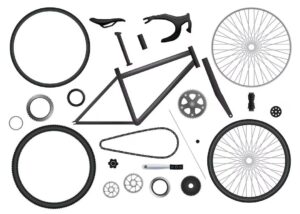एक हल्की बाइक बढ़ी हुई चपलता प्रदान करती है, बेहतर पैंतरेबाज़ी, और दक्षता में वृद्धि हुई, सवारों को अधिक आसानी और आनंद के साथ विविध इलाकों को जीतने के लिए अनुमति देना. चाहे आप चुनौतीपूर्ण पर्वत ट्रेल्स से निपट रहे हों, शहर की सड़कों पर हलचल करना, या खुली सड़कों पर गति के लिए लक्ष्य, आपकी बाइक का वजन आपके समग्र प्रदर्शन और अनुभव में एक महत्वपूर्ण भूमिका निभाता है. लेकिन क्या वास्तव में एक हल्के बाइक का गठन करता है? सवारों के लिए सबसे अच्छा हल्का बाइक क्या है? इस आलेख में, हम बाइक के वजन को अच्छी तरह से समझाएंगे. तो प्रतीक्षा करें? चलो साइकिल ज्ञान में देरी करते हैं.
औसत साइकिल का वजन क्या है?
जब वजन की बात आती है, विभिन्न प्रकार की बाइक के औसत वजन को समझना आपको एक सूचित निर्णय लेने में मदद कर सकता है. आइए विभिन्न औसत साइकिल वेट में देरी करें:
औसत पर्वत बाइक वजन
औसत पर, पहाड़ की बाइक के बीच तौलना 9.5-13.1 किलोभास. इन बाइक को बीहड़ इलाकों और अलग -अलग ट्रेल स्थितियों को संभालने के लिए डिज़ाइन किया गया है, जो अन्य बाइक प्रकारों की तुलना में उनके थोड़े भारी निर्माण में योगदान कर सकता है.

औसत सड़क बाइक वजन
के लिए सड़क बाइक, लाइटर को अक्सर बेहतर माना जाता है, विशेष रूप से चढ़ाई के उद्देश्यों के लिए. एक हाई-एंड रोड बाइक आमतौर पर वज़न होता है 6.8-7.7 किलोभास (15-17 पाउंड), जबकि मिड-रेंज मॉडल से हो सकते हैं 8.1-10 किलोभास (18-20 पाउंड). The वायुगतिकीय अभिकर्मक और सड़क बाइक में गति पर जोर अक्सर एक हल्के फ्रेम को प्राथमिकता देता है.

औसत शहर बाइक वजन
शहर की बाइक, शहरी या कम्यूटर बाइक के रूप में भी जाना जाता है, आम तौर पर दैनिक शहर के कम्यूटिंग और अवकाश की सवारी के लिए एक मध्यम वजन सीमा के भीतर आते हैं. जबकि निर्माताओं के कारण विशिष्ट डेटा भिन्न हो सकते हैं’ विवेक, ये बाइक आमतौर पर चारों ओर वजन करते हैं 8.32 किलोभास (18.34 एलबीएस) औसत पर. आप अलग -अलग कम्यूटिंग बाइक प्रकारों के औसत भार को समझकर इच्छित उपयोग और वरीयताओं के आधार पर अपने चयन का मार्गदर्शन कर सकते हैं.

औसत स्कूटर वजन
स्कूटर का वजन उनकी चपलता और उपयोग में आसानी में महत्वपूर्ण है. औसत पर, स्कूटर एक वजन स्पेक्ट्रम प्रदर्शित करते हैं जो विभिन्न वरीयताओं और कार्यात्मकताओं को पूरा करता है. हाल के वर्षों में, हल्के स्कूटर की ओर प्रवृत्ति ध्यान देने योग्य रही है. प्रो बाइक ने सिर्फ औसत वजन दर्ज किया 7.04 किलोभास पीठ में 2015, विशेष of चढ़ाई के साथ’ बाइक भी 6.99 किग्रा पर हल्की है. लेकिन अब स्कूटर आमतौर पर होते हैं 3.6-5.4 किलोभास (8-12 पाउंड), डिजाइन और इच्छित उपयोग के आधार पर भिन्नता के साथ. कम वजन पर यह जोर बढ़ाया गति और गतिशीलता की खोज के साथ संरेखित करता है. उदाहरण के लिए, ए 7 केजी स्कूटर को 9 किग्रा एक महत्वपूर्ण है 29% भार अंतर. उन्हें उठाने के दौरान इस विपरीत को अलग -अलग दिखाया जा सकता है, सवारी के दौरान वास्तविक प्रभाव सतहों, विशेष रूप से ऊपर की ओर चढ़ता है जहां कुल सिस्टम वजन प्रदर्शन को प्रभावित करता है (हैंडलिंग और त्वरण).

बाइक के लिए एक अच्छा वजन क्या है?
जब एक बाइक के वजन पर विचार किया जाता है, यह निर्धारित करना कि एक इष्टतम वजन क्या है, आपके सवारी के अनुभव को काफी प्रभावित कर सकता है. आइए एक सूचित विकल्प बनाने में मदद करने के लिए विभिन्न प्रकार की बाइक के लिए आदर्श भार का पता लगाएं:
एक पहाड़ी बाइक के लिए एक अच्छा वजन
एक पहाड़ी बाइक के लिए एक अच्छा वजन आमतौर पर से होता है 11-14 किलोभास (25-30 पाउंड). यह वजन रेंज ऑफ-रोड इलाके के लिए स्थायित्व और चपलता के बीच संतुलन बनाती है. हल्का पर्वत बाइक, आस-पास 11.3 किलोभास (25 पाउंड), अक्सर तकनीकी ट्रेल्स पर उनकी गतिशीलता के लिए पसंदीदा होते हैं, जबकि थोड़ा भारी मॉडल, तक 13.6 किलोभास (30 पाउंड), बीहड़ इलाके और डाउनहिल की सवारी के लिए जोड़ा स्थिरता और शक्ति प्रदान करें.
एक सड़क बाइक के लिए एक अच्छा वजन
एक हल्के वजन सड़क बाइक के लिए, एक आदर्श वजन के बीच गिरता है 6.8-9 किलोभास (15-20 पाउंड). लाइटर रोड बाइक उनकी दक्षता और पक्की सतहों पर गति के लिए बेशकीमती हैं. पेशेवर रेसिंग बाइक अक्सर करीब वजन करते हैं 6.8 किलोभास (15 पाउंड), साइकिल चालकों को जल्दी से तेज करने और उच्च गति बनाए रखने में सक्षम करना. तथापि, सड़क बाइक का वजन ऊपर है 9 किलोभास (20 पाउंड) बहुत अधिक गति का त्याग किए बिना लंबी दूरी की सवारी के लिए बढ़ी हुई स्थायित्व और आराम प्रदान कर सकते हैं.
एक शहर बाइक के लिए एक अच्छा वजन
शहर की बाइक आमतौर पर चारों ओर वजन करती है 11-16 किलोभास (25-35 पाउंड). ये बाइक शहरी कम्यूटिंग के लिए आराम और बहुमुखी प्रतिभा को प्राथमिकता देती हैं. जबकि लाइटर सिटी बाइक, हल्के तह बाइक की तरह, ट्रैफ़िक में आसान गतिशीलता और तंग स्थानों को नेविगेट करते समय पेशकश करें, थोड़ा भारी मॉडल अतिरिक्त स्थिरता और शक्ति प्रदान कर सकते हैं, विशेष रूप से लोड ले जाने या किसी न किसी शहर की सड़कों पर सवारी करने के लिए.
एक स्कूटर के लिए एक अच्छा वजन
स्कूटर आमतौर पर बीच में वजन करते हैं 9-14 किलोभास (20-30 पाउंड). महिलाओं और पुरुषों के लिए हल्के बाइक में से एक के रूप में, इस वेट रेंज में छोटी दूरी की यात्रा के लिए पोर्टेबिलिटी और स्थिरता है. हल्का स्कूटर, आस-पास 9 किलोभास (20 पाउंड), ले जाने और पैंतरेबाज़ी करना आसान है, उन्हें छोटी यात्राओं या भीड़ -भाड़ वाले क्षेत्रों को नेविगेट करने के लिए आदर्श बनाना. भारी स्कूटर, तक 14 किलोभास (30 पाउंड), बढ़ी हुई स्थिरता और स्थायित्व की पेशकश कर सकते हैं, विशेष रूप से दैनिक आने या असमान सतहों पर सवारी करने के लिए.
इसके अतिरिक्त, राइडर समर्थन क्षमता को ध्यान में रखते हुए एक उपयुक्त स्कूटर वजन का निर्धारण करने में महत्वपूर्ण है. S1 इलेक्ट्रिक स्कूटर, उदाहरण के लिए, वजन का होता है 53 सवारों का समर्थन करते हुए पाउंड 300 पाउंड.
की तरफ बाइक निर्माता, कुछ अक्सर इष्टतम प्रदर्शन और सुरक्षा मानकों को बनाए रखने के लिए स्कूटर के लिए वजन सीमा निर्धारित करते हैं. मानदंड जैसे कि अधिकतम वजन क्षमता 220 स्कूटर का वजन रखते हुए पाउंड 40 पाउंड या उससे कम उपयोगकर्ता-केंद्रित डिजाइन के लिए उद्योग की प्रतिबद्धता को उजागर करें.
क्या एक बाइक हल्का वजन बनाता है?
क्यों एक हल्की बाइक इतनी हल्की है? यह सवाल कई सवारों को भ्रमित कर सकता है. अब पढ़ें और वजन को प्रभावित करने वाले कारकों का पता लगाएं.
सामग्री चयन और निर्माण
सामग्री की पसंद एक बाइक के वजन को काफी प्रभावित करती है. निर्माता अक्सर हल्के अभी तक टिकाऊ सामग्री के लिए चुनते हैं जैसे अल्युमीनियम, कार्बन फाइबर, और टाइटेनियम फ्रेम का निर्माण करने के लिए, कांटे, और घटक.
- अल्युमीनियम: अपने हल्के स्वभाव और सामर्थ्य के लिए जाना जाता है, एल्यूमीनियम फ्रेम एंट्री-लेवल में मिड-रेंज बाइक में प्रचलित हैं. वे वजन और स्थायित्व के बीच एक अच्छा संतुलन प्रदान करते हैं, उन्हें विभिन्न सवारी स्थितियों के लिए आदर्श बनाना.
- कार्बन फाइबर: अपने असाधारण शक्ति-से-वजन अनुपात के लिए प्रसिद्ध, कार्बन फाइबर को उच्च-अंत बाइक में पसंद किया जाता है, जो कठोरता या प्रदर्शन से समझौता किए बिना वजन कम करने की क्षमता के कारण होता है. यह सामग्री जटिल डिजाइनों के लिए अनुमति देती है जो वायुगतिकी और आराम का अनुकूलन करते हैं.
- टाइटेनियम: हालांकि एल्यूमीनियम या कार्बन फाइबर की तुलना में कम आम है, टाइटेनियम फ्रेम उनके स्थायित्व के लिए बेशकीमती हैं, संक्षारण प्रतिरोध, और हल्कापन. जबकि टाइटेनियम बाइक pricier होती है, वे कई साइकिल चालकों द्वारा मांगी गई एक अनूठी सवारी गुणवत्ता प्रदान करते हैं.
घटक चयन
फ्रेम सामग्री के अलावा, घटकों की पसंद भी बाइक के समग्र वजन का निर्धारण करने में महत्वपूर्ण भूमिका निभाती है. जैसे घटक पहियों, ड्राइवट्रेन, हैंडल, और काठी बाइक के द्रव्यमान में महत्वपूर्ण योगदान दें.
- पहियों: कार्बन फाइबर या उच्च-ग्रेड एल्यूमीनियम जैसी सामग्रियों से बने हल्के पहिए घूर्णी वजन को कम करते हैं, त्वरण और गतिशीलता को बढ़ाना.
- ड्राइवट्रेन: हल्के मिश्र धातुओं से बने डेरिलर्स और कैसेट जैसे उच्च गुणवत्ता वाले ड्राइवट्रेन घटकों के लिए चयन करना, चिकनी गियर शिफ्ट को सुनिश्चित करते हुए बाइक के समग्र वजन को और अधिक ट्रिम कर सकता है.
डिजाइन अनुकूलन
निर्माता ताकत या प्रदर्शन से समझौता किए बिना बाइक संरचनाओं को सुव्यवस्थित करने के लिए उन्नत डिजाइन तकनीकों को नियोजित करते हैं. ब्यूटेड ट्यूब जैसी विशेषताएं, जहां ट्यूब की दीवारें संरचनात्मक अखंडता का त्याग किए बिना अतिरिक्त सामग्री को कम करने के लिए उनकी लंबाई के साथ मोटाई में भिन्न होती हैं, अनावश्यक वजन को दूर करने में मदद करें.
प्रदर्शन पर प्रभाव
एक बाइक का वजन सीधे विभिन्न इलाकों पर इसके प्रदर्शन को प्रभावित करता है. लाइटर बाइक को राइडर से कम ऊर्जा व्यय की आवश्यकता होती है, जो कि कम होने के कारण पर्वतारोहियों और त्वरण के दौरान तेजी से होता है. यह बेहतर गति क्षमताओं और बढ़ी हुई हैंडलिंग सटीकता में अनुवाद करता है.
क्यों लाइट बाइक अधिक महंगी है?
प्रकाश बाइक की लागत पर विचार करते समय, कई कारक खेल में आते हैं, बाइकिंग उद्योग के भीतर मूल्य निर्धारण की गतिशीलता को प्रभावित करना. इन तत्वों को समझना बाइक के वजन और लागत के बीच संबंध पर प्रकाश डालता है, उपभोक्ताओं को उनके क्रय निर्णयों में मार्गदर्शन करना.
सामग्री चयन और लागत निहितार्थ
सामग्री की पसंद एक बाइक के वजन को काफी प्रभावित करती है और, फलस्वरूप, इसकी कीमत बिंदु. हल्के अभी तक टिकाऊ सामग्री जैसे कि कार्बन फाइबर और टाइटेनियम अक्सर उच्च-प्रदर्शन बाइक के लिए इष्ट होते हैं, जो संरचनात्मक अखंडता से समझौता किए बिना समग्र वजन कम करने की उनकी क्षमता के कारण होते हैं. तथापि, ये उन्नत सामग्री एक प्रीमियम लागत पर आती है, लाइटर बाइक से जुड़े उच्च मूल्य टैग में योगदान.
के विपरीत, जैसे अधिक सामान्य सामग्रियों से निर्मित बाइक अल्युमीनियम वजन में कमी और सामर्थ्य के बीच संतुलन प्रदान कर सकता है. जबकि एल्यूमीनियम फ्रेम हल्के और लागत प्रभावी होते हैं, वे कार्बन फाइबर या टाइटेनियम के समान वजन बचत के समान स्तर को प्राप्त नहीं कर सकते हैं, उनके उच्च अंत समकक्षों की तुलना में एक मध्यम मूल्य सीमा के परिणामस्वरूप.
प्रदर्शन वृद्धि और तकनीकी नवाचार
हल्के बाइक अक्सर अत्याधुनिक प्रौद्योगिकियों और डिजाइन नवाचारों को शामिल करती हैं, जिसका उद्देश्य प्रदर्शन मेट्रिक्स जैसे गति के अनुकूलन करना है, चपलता, और वायुगतिकी. वायुगतिकीय फ्रेम आकृतियों जैसी विशेषताएं, एकीकृत केबल मार्ग प्रणाली, और उन्नत निलंबन घटक बढ़ाया सवारी अनुभवों में योगदान करते हैं, लेकिन समग्र उत्पादन लागतों में भी जोड़ते हैं.
निर्माता इन तकनीकी प्रगति को परिष्कृत करने के लिए अनुसंधान और विकास में भारी निवेश करते हैं, बेहतर प्रदर्शन क्षमता देने के लिए बाइक डिजाइन की सीमाओं को धक्का देना. ये नवाचार उच्च उत्पादन लागत में अनुवाद करते हैं जो मानक मॉडल की तुलना में हल्के बाइक की अंतिम खुदरा कीमतों में परिलक्षित होते हैं.
बाजार की मांग और ब्रांड पोजिशनिंग
साइकिल के उत्साही लोगों के बीच हल्की बाइक की मांग प्रीमियम लाइटवेट मॉडल का उत्पादन करने की दिशा में बाजार के रुझान को बढ़ाती है जो विशिष्ट सवारी वरीयताओं को पूरा करती है. लाइटवेट बाइक टेक्नोलॉजी में नेताओं के रूप में खुद को पोजिशनिंग करना अक्सर गुणवत्ता शिल्प कौशल और नवाचार के लिए अपनी प्रतिष्ठा के आधार पर उच्च कीमतों की कमान संभालता है.
शीर्ष स्तरीय प्रदर्शन और अद्वितीय सवारी के अनुभव की तलाश करने वाले उपभोक्ता महंगी हल्की बाइक में निवेश करने के लिए तैयार हैं जो बेहतर हैंडलिंग की पेशकश करते हैं, जवाबदेही, और गति लाभ. यह मांग-आपूर्ति गतिशील उद्योग के भीतर मूल्य निर्धारण रणनीतियों को प्रभावित करती है, पारंपरिक बाइक विकल्पों की तुलना में उच्च मूल्य स्तर पर तैनात प्रीमियम लाइटवेट मॉडल के साथ.
अनुकूलन विकल्प और निजीकरण सुविधाएँ
हल्के बाइक निर्माता अक्सर प्रदान करते हैं अनुकूलन विकल्प यह सवारों को व्यक्तिगत वरीयताओं के अनुसार अपने बाइकिंग अनुभव को दर्जी करने की अनुमति देता है. अल्ट्रा-लाइट व्हील्स या कार्बन फाइबर हैंडलबार जैसे विशिष्ट घटकों का चयन करने से कस्टम पेंट फिनिश या व्यक्तिगत सामान तक, ये जोड़ा सुविधाएँ हल्के बाइक की समग्र लागत में योगदान करती हैं. जबकि ये व्यक्तिगत स्पर्श प्रकाश बाइक की विशिष्टता को बढ़ाते हैं, वे अतिरिक्त खर्च भी उठाते हैं जो उनके प्रीमियम मूल्य निर्धारण संरचना में योगदान करते हैं.
निष्कर्ष
सारांश, एक हल्के बाइक की अवधारणा एक पैमाने पर सिर्फ संख्याओं से अधिक शामिल है - यह प्रदर्शन के सार का प्रतीक है, बहुमुखी प्रतिभा, और साइकिल चलाने में आनंद. माउंटेन बाइकिंग से लेकर सिटी कम्यूटिंग तक, बाइक के वजन के महत्व को अनदेखा नहीं किया जा सकता है. एक हल्के बाइक के कार्यों को पहचानने और विभिन्न सवारी विषयों के लिए इसकी इष्टतम वजन सीमा को समझने से, साइकिल चालक सूचित विकल्प बना सकते हैं जो उनके सवारी अनुभव को बढ़ाते हैं और सड़क या निशान पर अपनी क्षमता को अधिकतम करते हैं.
उपवास
है 30 एक पहाड़ी बाइक के लिए भारी lbs?
हाँ, यह अपेक्षाकृत भारी है. तथापि, एक बाइक तकनीशियन के अनुसार, एक पहाड़ी बाइक के आसपास वजन 30 पाउंड दृढ़ता और गतिशीलता की पेशकश कर सकते हैं. यह वजन सीमा यह सुनिश्चित करती है कि बाइक चुनौतीपूर्ण ट्रेल्स के दौरान नियंत्रण प्रदान करते हुए बीहड़ इलाकों का सामना कर सकती है.
है 25 एक बाइक के लिए पाउंड प्रकाश?
हाँ, 25 पाउंड को बाइक के लिए हल्का माना जाता है, विशेष रूप से कुछ प्रकार के लिए जैसे सड़क बाइक और पहाड़ी बाइक. लाइटर बाइक अक्सर परिवहन के लिए आसान होती है, इकट्ठा करना, और यातायात स्थितियों में उठाएं, चपलता और जवाबदेही की तलाश करने वाले सवारों के लिए समग्र सुविधा बढ़ाना.
एक पहाड़ी बाइक के लिए प्रकाश माना जाता है?
लगभग एक वजन सीमा 22 को 28 एक पहाड़ी बाइक के लिए पाउंड आमतौर पर प्रकाश माना जाता है. इस रेंज के भीतर बाइक बढ़ी हुई चपलता की पेशकश करते हैं, गतिशीलता, और दक्षता, चुनौतीपूर्ण ट्रेल्स से निपटने और ऑफ-रोड इलाके में प्रदर्शन को अधिकतम करने के लिए उन्हें अच्छी तरह से अनुकूल बनाना.
सबसे हल्के सड़क बाइक किस से बनी हैं?
सबसे हल्की सड़क बाइक आमतौर पर बनी होती है कार्बन फाइबर, टाइटेनियम मिश्र धातु, और उच्च श्रेणी के एल्यूमीनियम, उनके असाधारण शक्ति-से-वजन अनुपात के लिए प्रसिद्ध. ये फ्रेम और घटक सड़क पर इष्टतम प्रदर्शन के लिए कठोरता और जवाबदेही को बनाए रखते हुए समग्र बाइक के वजन को कम कर सकते हैं.

















